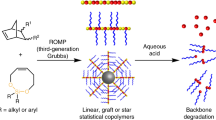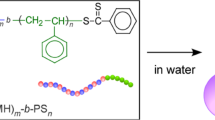Abstract
Amphiphilic miktoarm star copolymers have a unique internal structure and many attractive properties with respect to solution self-assembly, such as a high density of internal and peripheral functionalities, low CMC values, and high loading efficiency. However, compared to their linear analogs, the complex architecture demands asymmetric polymer arms emanating from a single core, which poses a significant synthetic challenge. Herein, we demonstrate an approach for the synthesis of polypept(o)ide-based AB3- and A3B-type miktoarm PeptoStars consisting of polypeptidic poly(γ-benzyl-l-glutamate (pGlu(OBn)) as the hydrophobic A arm and polypeptoidic polysarcosine (pSar) as the hydrophilic B arm. These structures, which are completely derived from endogenous amino acids, were realized by the core-first method using a tetrafunctional initiator and the corresponding N-carboxyanhydrides (NCAs) via a controlled, living nucleophilic ring-opening polymerization (ROP). The asymmetric architecture was achieved through an orthogonal protecting group strategy with multiple protection/deprotection steps. Characterization via 1H NMR-, 1H DOSY-spectroscopy, and size-exclusion chromatography (SEC) indicate the presence of well-formed miktoarm PeptoStars with low dispersities (Đ = 1.09–1.14), the precise control over the degree of polymerization and Poisson-like molecular weight distributions.
This is a preview of subscription content, access via your institution
Access options
Subscribe to this journal
Receive 12 print issues and online access
$259.00 per year
only $21.58 per issue
Buy this article
- Purchase on Springer Link
- Instant access to full article PDF
Prices may be subject to local taxes which are calculated during checkout







Similar content being viewed by others
References
Aghajanzadeh M, Zamani M, Rostamizadeh K, Sharafi A. The role of miktoarm star copolymers in drug delivery systems. J Macromol Sci Part A Pure Appl Chem. 2018;55:559–71.
Guo Y, Pan C & Wang J. Block and star block copolymers by mechanism transformation. VI. Synthesis and characterization of A4B4 miktoarm star copolymers consisting of polystyrene and polytetrahydrofuran prepared by cationic ring-opening polymerization and atom transfer radical polymerization. J Polym Sci A: Polym Chem. 2001;39:2134–42.
Hadjichristidis N, Iatrou H, Pitsikalis M, Mays J. Macromolecular architectures by living and controlled/living polymerizations. Prog Polym Sci. 2006;31:1068–132.
Zhang L, Zhang W, Zhou N, Zhu J, Zhang Z, Cheng Z, et al. Preparation and characterization of linear and miktoarm star side-chain liquid crystalline block copolymers with p-methoxyazobenzene moieties via a combination of ATRP and ROP. J Macromol Sci Part A. 2009;46:876–85.
Altintas O, Vogt AP, Barner-Kowollik C, Tunca U. Constructing star polymers via modular ligation strategies. Polym Chem. 2012;3:34–45.
Schäfer O, Klinker K, Braun L, Huesmann D, Schultze J, Koynov K, et al. Combining orthogonal reactive groups in block copolymers for functional nanoparticle synthesis in a single step. ACS Macro Lett. 2017;6:1140–5.
Ding J, Chen L, Xiao C, Chen L, Chen L. Micelles for controlled drug delivery. Chem Commun. 2014;50:11274–90.
Kataoka K, Harada A, Nagasaki Y. Block copolymer micelles for drug delivery: design, characterization and biological significance. Adv Drug Deliv Rev. 2012;64:37–48.
Kataoka K, Harada A, Nagasaki Y. Block copolymer micelles for drug delivery: design, characterization and biological significance. Adv Drug Deliv Rev. 2001;47:113–31.
Barz M, Luxenhofer R, Zentel R, Vicent MJ. Overcoming the PEG-addiction: well-defined alternatives to PEG, from structure-property relationships to better defined therapeutics. Polym Chem. 2011;2:1900–18.
Sun Q, Barz M, De Geest BG, Diken M, Hennink WE, Kiessling F, et al. Nanomedicine and macroscale materials in immuno-oncology. Chem Soc Rev. 2019;48:351–81.
Talelli M, Barz M, Rijcken CJF, Kiessling F, Hennink WE & Lammers T. Core-crosslinked polymeric micelles: principles, preparation, biomedical applications and clinical translation. Nano Today. 2015;10:93–117.
Soliman GM, Sharma A, Maysinger D, Kakkar A. Dendrimers and miktoarm polymers based multivalent nanocarriers for efficient and targeted drug delivery. Chem Commun. 2011;47:9572–87.
Deng Y, Zhang S, Lu G, Huang X. Constructing well-defined star graft copolymers. Polym Chem. 2013;4:1289–99.
Khanna K, Varshney S, Kakkar A. Miktoarm star polymers: advances in synthesis, self-assembly, and applications. Polym Chem. 2010;1:1171–85.
Yoon K, Kang HC, Li L, Cho H, Park MK, Lee E, et al. Amphiphilic poly(ethylene glycol)-poly(ε-caprolactone) AB 2 miktoarm copolymers for self-assembled nanocarrier systems: synthesis, characterization, and effects of morphology on antitumor activity. Polym Chem. 2015;6:531–42.
Yin H, Kang SW, Bae YH. Polymersome formation from AB2 type 3-miktoarm star copolymers. Macromolecules. 2009;42:7456–64.
Li Z, Kesselman E, Talmon Y, Hillmyer MA, Lodge TP. Multicompartment micelles from ABC miktoarm stars in water. Science. 2004;306:98–101.
Moquin A, Sharma A, Cui Y, Lau A, Maysinger D, Kakkar A, et al. Asymmetric AB3 Miktoarm star polymers: synthesis, self-assembly, and study of micelle stability using AF 4 for efficient drug delivery. Macromol Biosci. 2015;15:1744–54.
Alkilany AM, Zhu L, Weller H, Mews A, Parak WJ, Barz M. et al. Ligand density on nanoparticles: a parameter with critical impact on nanomedicine. Adv Drug Deliv Rev. 2019. https://doi.org/10.1016/j.addr.2019.05.010.
Wang M, Zhang X, Peng H, Zhang M, Zhang X, Liu Z, et al. Optimization of amphiphilic miktoarm star copolymers for anticancer drug delivery. ACS Biomater Sci Eng. 2018;4:2903–10.
Xu F, Wu D, Huang Y, Mai Y. Multi-dimensional self-assembly of a dual-responsive abc miktoarm star terpolymer. ACS Macro Lett. 2017;6:426–30.
Kimura S, Kidchob T, Imanishi Y. Controlled release from amphiphilic polymer aggregates. Polym Adv Technol. 2001;12:85–95.
Birke A, Huesmann D, Kelsch A, Weilba M, Xie J, Bros M, et al. Polypeptoid-block-polypeptide copolymers: synthesis, characterization, and application of amphiphilic block copolypept(o)ides in drug formulations and miniemulsion techniques. Biomacromolecules. 2014;15:548–57.
Heller P, Birke A, Huesmann D, Weber B, Fischer K, Reske-kunz A, et al. Introducing peptoplexes: polylysine- block—polysarcosine based polyplexes for transfection of HEK 293T cells. Macromol Biosci. 2014;14:1380–95.
Klinker K, Barz M. Polypept(o)ides: hybrid systems based on polypeptides and polypeptoids. Macromol Rapid Commun. 2015;36:1943–57.
Klinker K, Schäfer O, Huesmann D, Bauer T, Capeloa L, Braun L, et al. Secondary-structure-driven self-assembly of reactive polypept(o)ides: controlling size, shape, and function of angewandte. Angew Chem. 2017;56:9608–13.
Hörtz C, Birke A, Kaps L, Decker S, Wächtersbach E, Fischer K, et al. Cylindrical brush polymers with polysarcosine side chains: a novel biocompatible carrier for biomedical applications. Macromol Symp. 2015;48:2074–86.
Huesmann D, Sevenich A, Weber B, Barz M. A head-to-head comparison of poly (sarcosine) and poly (ethylene glycol) in peptidic, amphiphilic block copolymers. Polymers. 2015;67:240–8.
Chen X, Ferrigno R, Yang J, Whitesides GM. Redox properties of cytochrome c adsorbed on self-assembled monolayers: a probe for protein conformation and orientation. Langmuir. 2002;18:7009–15.
Matsui H, Tada Y, Fushimi R, Fujita S, Ito M, Kawabe T, et al. Novel class of nanofiber hydrogels based on the biodegradable amphiphilic copolymers poly(sarcosine) and poly(L-lactic acid) and prepared using alcohols. Mater Today Commun. 2017;11:156–62.
Birke A, Ling J, Barz M. Polysarcosine-containing copolymers: synthesis, characterization, self-assembly, and applications. Prog Polym Sci. 2018;81:163–208.
Weber B, Birke A, Fischer K, Schmidt M, Barz M. Solution properties of polysarcosine: from absolute and relative molar mass determinations to complement activation. Macromolecules. 2018;51:2653–61.
Chapman RG, Ostuni E, Takayama S, Holmlin RE, Yan L, Whitesides GM. Surveying for surfaces that resist the adsorption of proteins. J Am Chem Soc 2000;122:8303–4.
Lau KHA, Ren C, Sileika TS, Park SH, Szleifer I, Messersmith PB. Surface-grafted polysarcosine as a peptoid antifouling polymer brush. Langmuir. 2012;28:16099–107.
Schneider M, Tang Z, Richter M, Marschelke C, Wegener E, Amin I, et al. Patterned polypeptoid brushes. Macromol Biosci. 2015;16:75–81.
Fokina A, Klinker K, Braun L, Jeong BG, Bae WK, Barz M, et al. Multidentate polysarcosine-based ligands for water-soluble quantum dots. Macromolecules. 2016;49:3663–71.
Negwer I, Best A, Schinnerer M, Schäfer O, Capeloa L, Wagner M, et al. Monitoring drug nanocarriers in human blood by near-infrared fluorescence correlation spectroscopy. Nat Commun. 2018;9:5306.
Oya M, Katakai R, & Nakai H, Chem Lett. 1973;2:1143–4.
Fetsch C, Grossmann A, Holz L, Nawroth JF, Luxenhofer R. Polypeptoids from N-substituted glycine N-carboxyanhydrides: hydrophilic, hydrophobic, and amphiphilic polymers with poisson distribution. Macromolecules. 2011;44:6746–58.
Kricheldorf HR, Bösinger K. Mechanismus der NCA-Polymerisation, Über die Amin katalysierte Polymerisation von Sarkosin -NCA und -NTA. Makromol Chem. 1976;177:1243–58.
Dimitrov I & Schlaad H. Synthesis of nearly monodisperse polystyrene—polypeptide block copolymers via polymerisation of N-carboxyanhydrides. Chem Commun. 2003;23:2944–5.
Heller P, Hobernik D, Lächelt U, Schinnerer M, Weber B, Schmidt M, et al. Combining reactive triblock copolymers with functional cross-linkers: a versatile pathway to disulfide stabilized-polyplex libraries and their application as pDNA vaccines. J Control Release. 2017;258:146–60.
Holm R, Weber B, Heller P, Klinker K, Westmeier D, Docter D, et al. Synthesis and characterization of stimuli-responsive star-like polypept(o)ides: introducing biodegradable peptostars. Macromol Biosci. 2017;17:1–14.
Holm R, Douverne M, Weber B, Bauer T, Best A, Ahlers P, et al. Impact of branching on the solution behavior and serum stability of starlike block copolymers. Biomacromolecules. 2019;20:375–88.
Kricheldorf HR, Kreiser-Saunders I, Stricker A. Polylactones 48. SnOct2-initiated polymerizations of lactide: a mechanistic study. Macromolecules. 2000;33:702–9.
Frisch H, Nie Y, Raunser S, Besenius P. PH-regulated selectivity in supramolecular polymerizations: switching between co- and homopolymers. Chem Eur J. 2015;21:3304–9.
Frisch H, Spitzer D, Haase M, Basché T, Voskuhl J, Besenius P. Probing the self-assembly and stability of oligohistidine based rod-like micelles by aggregation induced luminescence. Org Biomol Chem. 2016;14:5574–9.
Fetsch C, Luxenhofer R. Thermal properties of aliphatic polypeptoids. Polymers 2013;5:112–27.
Sulistio A, Gurr PA, Blencowe A, Qiao GG. Peptide-based star polymers: the rising star in functional polymers. Aust J Chem. 2012;65:978–84.
Shi Y, Lammers T, Storm G, Hennink WE. Physico-chemical strategies to enhance stability and drug retention of polymeric micelles for tumor-targeted drug delivery. Macromol Biosci. 2017;17:1–11.
Habraken GJM, Wilsens KHRM, Koning CE, Heise A. Optimization of N-carboxyanhydride (NCA) polymerization by variation of reaction temperature and pressure. Polym Chem. 2011;2:1322–30.
Author information
Authors and Affiliations
Corresponding author
Additional information
Publisher’s note Springer Nature remains neutral with regard to jurisdictional claims in published maps and institutional affiliations.
Supplementary information
Rights and permissions
About this article
Cite this article
Schwiertz, D., Holm, R. & Barz, M. Facile synthesis of amphiphilic AB3 and A3B miktoarm PeptoMiktoStars. Polym J 52, 119–132 (2020). https://doi.org/10.1038/s41428-019-0269-1
Received:
Revised:
Accepted:
Published:
Issue Date:
DOI: https://doi.org/10.1038/s41428-019-0269-1



